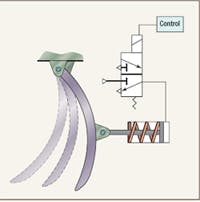Machine goes nuts with pneumatics
As with any food processing application, there’s a tremendous need for speed to get freshly harvested walnuts from grove to market. In automated harvesting, walnuts are plucked from trees using a mechanical device, then dumped into a chute and into a sorter. The sorter separates out nuts that are immature or otherwise don’t measure up to quality standards. The sooner this occurs, the better, because further processing of a substandard nut wastes time and money. Therefore, nuts fresh off the trees often are sorted right in the grove before being sent to plants for further processing.
As with most bulk handl ing operations, the nuts cascade through the sorter at random. Field sorting machines typically consist of a linear system of vision sensors that constantly sends images of walnuts passing by to a central processor. The processor then compares the images with pre-determined criteria for accepting or rejecting each individual nut. Once the comparison is made, nothing happens to acceptable nuts. However, when an unacceptable one is detected, the processor sends a signal to remove the walnut from the processing line.
An early solution
In conventional systems, the signal from the processor energizes the solenoid of an air valve, which, in turn, routes compressed air to extend a singleacting, spring-return cylinder (see illustration). A paddle attached to the cylinder’s rod end quickly deploys to eject the sub-standard walnut. The time between detection of a substandard nut and deployment of the paddle requires 45 to 50 msec. Pneumatics is a natural for this application because of its continuous rapid cycling capability. An electromechanical solution, on the other hand, could be prone to overheating.
This pneumatic actuation was quick and reliable when the systems were introduced years ago. However, as the speed of vision signal processing systems increased, speed limitations of the original electropneumatic sorting mechanism prevented increasing machine throughput. Also, the many mechanical parts required regular maintenance. And even though the electropneumatic system was reliable, the mechanical linkages were prone to malfunction. The harvest season for walnuts is brief, so downtime is costly.
A more pneumatic solution
The builder of the nut sorter approached Matrix Air Valves, Canyon Country, Calif., for a comprehensive overhaul of its existing system. The redesigned system did away with the paddles, cylinders, and linkages. Doing so eliminated the speed limitations, required maintenance, and susceptibility to down time.
Instead, the system uses air valves to instantly provide a puff of compressed air to divert substandard walnuts out of the production flow. So instead of requiring a 45 to 50 msec activation cycle, the redesigned system can actuate within 1 msec of receiving a signal from the system processor.
The key to this high-speed operation are Matrix ultra-high-speed pneumatic valves. The sorter uses an array of Series 853 valves. Each valve has three outlet ports, which route compressed air to nozzles, and each port operates independent of the other two. Series 850 valves actually have nine independent outputs. But this machine requires only three, so an outlet manifold combines flow from three groups of three valve outlets.
The 3-outlet valve has a total CV of 1.7. It also features a 500,000,000 minimum cycle life, with no decay in performance over its life span. Its small size (each valve fits within a 2-in. cube) and low power consumption provide a more compact and efficient machine.
The system redesign was more of a retrofit because the original system configuration was left intact. The only changes were replacing the original valves, cylinders, paddles, and mechanical linkages with the Matrix valves.
Benefits of the retrofitted system include:
• An 80% increase in productivity by reducing total cycle time from 45 msec to 9 msec. (Response time of the Matrix valves can be as low as 0.5 msec, but other operational parameters prevented reducing cycle time further.)
• The company totally eliminated the cost of replacing cylinders, mechanical linkages, etc. (Up to 20,000 cylinders were replaced annually due to deterioration.)
• Downtime during critical harvest season was eliminated.
• Sorting efficiency improved from 80% to 98%, which eliminated the need to reprocess nuts.
Way beyond nuts
Any products that are discrete and distinguishable by color, contrast, or hue can be sorted using this method — as long as their trajectory can be adequately altered by a puff of air. Therefore, rice, cashews, capsules, tablets, coffee beans, and berries are just a few of other bulk products that can take advantage of this technology.
Information for this article was provided by Mohan David, of Matrix Air Valves, Canyon Country, Calif. For more information, call (661) 299-2762, or e-mail at [email protected].



